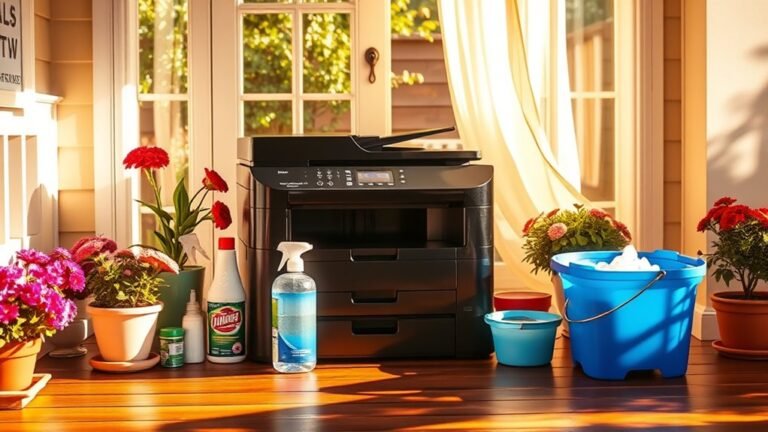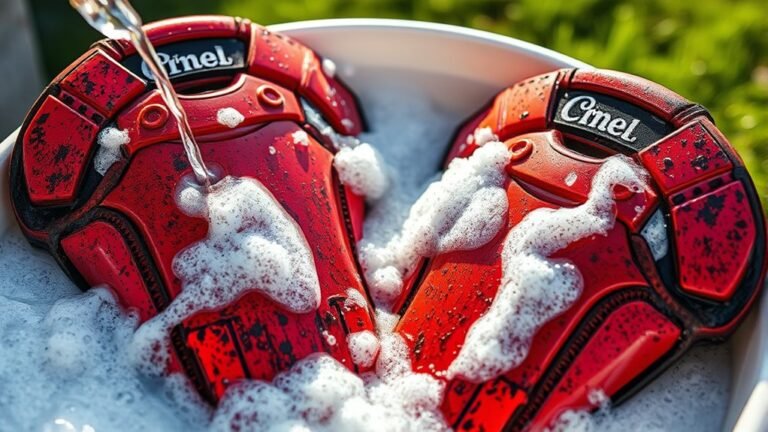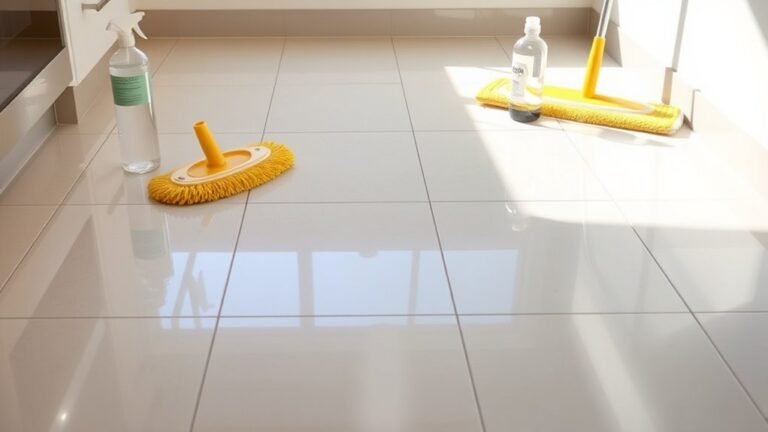How to Care for and Clean Leather Furniture
To care for and clean your leather furniture, keep it away from direct sunlight and heat to avoid fading and cracking. Dust regularly with a soft cloth or vacuum gently. When cleaning, use mild soap and water or eco-friendly products, avoiding harsh chemicals. Blot spills immediately and let leather air dry naturally. Condition it after cleaning to maintain softness and protection. By understanding these basics, you’ll guarantee your leather stays beautiful and durable for years to come.
Understanding Different Types of Leather

Leather comes in various types, each with unique qualities that affect how you should care for your furniture. When you choose aniline leather, you’re picking a material prized for its natural look and soft feel, but it’s more vulnerable to stains and fading since it lacks a protective coating. On the other hand, top grain leather offers a balance between durability and appearance. It’s slightly treated, making it more resistant to wear while still boasting a smooth surface. Knowing these differences lets you handle your leather with confidence, ensuring it stays beautiful without unnecessary restrictions. Embracing the freedom to enjoy your furniture means understanding its material so you can maintain it properly without losing its character or charm.
Daily Maintenance Tips for Leather Furniture
Knowing the type of leather your furniture is made from helps you decide how to care for it every day. Start by considering your furniture positioning—keep pieces away from direct sunlight and heat sources to prevent drying and cracking. Regular dust removal is essential; use a soft, dry cloth or a vacuum with a brush attachment to gently clear dust and debris. Avoid harsh chemicals or excessive moisture that can damage the leather’s surface. When moving your leather furniture, lift it carefully to avoid stressing the material or frame. By keeping these simple daily habits, you protect your leather’s natural beauty and maintain its freedom of movement and comfort, ensuring your furniture stays inviting and durable for years to come.
How to Properly Clean Leather Surfaces

To keep your leather furniture looking its best, you’ll need to choose the right cleaner suited for your leather type. Once you have the proper product, following a step-by-step cleaning process will help avoid damage and maintain its natural shine. Let’s walk through how to clean your leather surfaces safely and effectively.
Choosing the Right Cleaner
How do you pick the best cleaner for your leather furniture without causing damage? It starts with understanding your leather type since each demands a specific approach. Here’s how to choose wisely:
- Identify Your Leather Type: Whether it’s aniline, semi-aniline, or protected leather, knowing this guides your cleaner choice.
- Opt for Eco Friendly Options: Choose products free from harsh chemicals to keep your furniture safe and support a greener lifestyle.
- Test Before You Commit: Always spot-test a small, hidden area to verify the cleaner won’t discolor or dry out your leather.
Step-by-Step Cleaning Process
Although caring for leather might seem tricky at first, following a clear cleaning process can make it simple and effective. Start by identifying your leather types, as this affects the cleaning tools you’ll need. Use a soft brush or cloth to dust off dirt. Next, apply a mild cleaner designed for leather, and gently wipe in circular motions. Finally, condition the leather to keep it supple and protected.
| Step | Action | Recommended Tool |
|---|---|---|
| 1 | Remove dust and debris | Soft brush/cloth |
| 2 | Clean with appropriate solution | Leather cleaner |
| 3 | Condition and protect | Leather conditioner |
This method frees you from worries, letting your leather furniture shine and last longer.
Dealing With Stains and Spills on Leather
When spills happen on your leather furniture, acting quickly can make all the difference in preventing stains. Effective spill management is all about timely, gentle care. Here’s how to tackle stain removal without restricting your freedom to enjoy your space:
- Blot, don’t rub: Use a clean, dry cloth to gently blot the spill, absorbing as much liquid as possible without spreading it.
- Use mild soap solution: Mix a small amount of mild soap with water, dampen a cloth, and gently clean the stained area. Avoid harsh chemicals that can damage leather.
- Dry naturally: Let the leather air dry away from direct heat or sunlight to prevent cracking.
Conditioning and Protecting Leather Furniture

To keep your leather furniture looking its best, you’ll need to condition and protect it regularly. Leather treatments replenish natural oils, preventing dryness and cracking, and help maintain the supple feel you love. Choose products designed specifically for your leather finishes to avoid damage and guarantee effectiveness.
Apply conditioner every 6 to 12 months, depending on your climate and usage. This simple step extends your furniture’s life and keeps it looking fresh. Additionally, protecting leather from direct sunlight and heat sources preserves its color and texture. With the right care, your leather furniture won’t just endure—it’ll thrive, offering you freedom from constant worry and the joy of lasting comfort.
Avoiding Common Mistakes in Leather Care
When caring for your leather furniture, steer clear of harsh chemicals that can damage the material. You’ll also want to keep excess moisture away, as it can cause stains and weaken the leather. Avoiding these common mistakes will help your furniture last longer and look better.
Avoid Harsh Chemicals
One of the biggest mistakes you can make with leather furniture is using harsh chemicals for cleaning. These substances often contain ingredients that can strip the leather’s natural oils, causing it to dry out, crack, or discolor. To keep your leather looking its best while enjoying the freedom of easy care, consider these points:
- Opt for natural alternatives like mild soap and water or specially formulated leather cleaners.
- Avoid ammonia, bleach, or alcohol-based products due to their chemical risks that can damage the surface.
- Always test any cleaner on a hidden area first to verify it doesn’t harm the leather.
Prevent Excess Moisture
Excess moisture is a common culprit that can quickly damage your leather furniture if you’re not careful. To protect your pieces, prioritize humidity control in your living space. Too much moisture in the air can cause leather to warp, stain, or develop mildew, restricting your freedom to enjoy your furniture’s natural beauty. Consider using moisture absorbers like silica gel packs or dehumidifiers to maintain an ideal environment. These tools help keep leather supple without the risk of over-saturation. Avoid placing your furniture near sources of dampness, such as windows or humidifiers. By managing moisture wisely, you preserve your leather’s durability and appearance, giving you the freedom to relax without worry. Preventing excess moisture is key to keeping your leather furniture vibrant and long-lasting.
Frequently Asked Questions
Can Leather Furniture Be Repaired if Scratched or Torn?
Think of your leather furniture like a well-worn pair of boots—scuffs and scrapes tell a story but don’t have to hold you back. You can absolutely embrace freedom from flaws with scratch repair and tear restoration kits designed for DIY fixes. These tools let you reclaim your furniture’s smooth look without being chained to costly professional help. So, don’t let a scratch or tear limit your style; you’ve got the power to restore and roam free!
How Does Humidity Affect Leather Furniture Longevity?
You’ll want to keep an eye on humidity levels around your leather furniture because too much moisture can cause serious damage. High humidity promotes mold and mildew, while low humidity can dry out the leather, making it crack. Maintaining a balanced environment helps your leather stay supple and durable, so you can enjoy that freedom of relaxed, worry-free lounging without worrying about moisture damage cutting your furniture’s life short.
What Are the Best Products to Remove Pet Hair From Leather?
When tackling pet hair on your leather, you’ll want to grab pet hair removers designed to be gentle yet effective. Microfiber cloths, rubber gloves, or a soft-bristled brush are great cleaning tools that help lift hair without damaging the surface. You can even use a slightly dampened cloth to catch stubborn strands. These options let you free your furniture from fur without fuss, keeping your space clean and comfortable.
Is It Safe to Use Homemade Cleaning Solutions on Leather?
Sure, safety should steer your decision when dabbling in DIY cleaning. A vinegar solution, when wisely watered down, works well without wrecking your leather’s lustrous look. Adding essential oils can amplify aroma and antibacterial benefits, but always apply a small sample first to spot any sneaky stains or sensitivity. You’ve got freedom to freshen your furniture, but test thoroughly to keep your leather’s luxurious life lasting long.
How Often Should Leather Furniture Be Professionally Cleaned?
You should schedule professional cleaning frequency for your leather furniture about once a year to keep it looking fresh and lasting longer. It’s a solid leather maintenance tip that helps remove deep dirt and oils you can’t tackle with regular cleaning. Sticking to this routine gives you the freedom to enjoy your furniture without worrying about buildup or damage, keeping things smooth, soft, and stylish over time.






